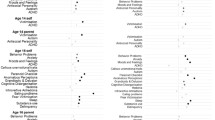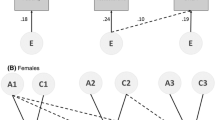Abstract
Pubertal development is an important focus of current biopsychosocial research. The Pubertal Development Scale or PDS (Petersen, Crockett, Richards, and Boxer, J. Youth Adolesc. (1988) 17: 117–133) has become a widely used measure in school-based and longitudinal research, because it incorporates several indices of pubertal development. This study reports normative data on the PDS for two population-based birth cohorts of Finnish twin boys and girls, assessed at ages 11–12 and 14. Additionally, we report longitudinal analyses of the associations between pubertal development and substance use, suggesting that the impact of pubertal timing is more complex than previously reported; associations commonly assumed between pubertal development and substance use held only for those whose developmental level, relative to peers, remained stable across follow-up. Finally, we report twin correlations for the PDS which suggest that sibling similarity for pubertal development arises from both shared genes and shared environments and that the patterns of these influences vary between sexes and across time.
Similar content being viewed by others
REFERENCES
Andersson, T., and Magnusson, D. (1990). Biological maturation in adolescence and the development of drinking habits and alcohol abuse among young males: A prospective longitudinal study. J. Youth Adolesc. 19: 33–41.
Aro, H., and Taipale, V. (1987). The impact of timing of puberty on psychosomatic symptoms among fourteen-to sixteen-year-old Finnish girls. Child Dev. 58: 261–268.
Brooks-Gunn, J. (1988). Antecedents and consequences of variations in girls' maturational timing. J. Adolesc. Health Care 9: 365–373.
Brooks-Gunn, J., and Warren, M. P. (1985). Measuring physical status and timing in early adolescence: A developmental perspective. J. Youth Adolesc. 14: 163–189.
Brooks-Gunn, J., Warren, M. P., Rosso, J., and Gargiulo, J. (1987). Validity of self-report measures of girls' pubertal status. Child Dev. 58: 829–841.
Caspi, A., Lynam, D., Moffitt, T. E., and Silva, P. A. (1993). Unraveling girls' delinquency: Biological, dispositional, and contextual contributions to adolescent misbehavior. Dev. Psychol. 29: 19–30.
Clausen, J. A. (1975). The social meaning of differential physical and sexual maturation. In Dragastin, S., and Elder, G. J. (eds.), Adolescence in the Life Cycle. Wiley, New York, pp. 25–47.
Compas, B. E., Hinden, B. R., and Gerhardt, C. A. (1995). Adolescent development: Pathways and processes of risk and resilience. Annu. Rev. Psychol. 46: 265–293.
Dick, D. M., Rose, R. J., Viken, R. J., and Kaprio, J. (2000). Pubertal timing and substance use: Associations between and within families across late adolescence. Dev. Psychol. 36: 180–189.
Ge, X., Conger, R. D., and Elder, G. H., Jr. (1996). Coming of age too early: Pubertal influences on girls' vulnerability to psychological distress. Child Dev. 67: 3386–3400.
Golden, W. L. (1981). Reproductive histories in a Norwegian twin population: Evaluation of the maternal effect in early spontaneous abortion. Acta. Genet. Med. Gemellol. 30: 91–165.
Jones, M. C., and Bayley, N. (1950). Physical maturing among boys as related to behavior. J. Educ. Psychol. 41: 129–148.
Kaprio, J., Koskenvuo, M., and Rose, R. J. (1990). Population-based twin registries: Illustrative applications in genetic epidemiology and behavioral genetics from the Finnish Twin Cohort Study. Acta. Genet. Med. Gemellol. 39: 427–439.
Kaprio, J., Rimpela, A., Winter, T., Viken, R. J., Rimpela, M., and Rose, R. J. (1995). Common genetic influences on BMI and age at menarche. Hum. Biol. 67: 739–753.
Koenig, L. J., and Gladstone, T. R. G. (1998). Pubertal development and school transition: Joint influences on depressive symptoms in middle and late adolescents. Behav. Modif. 22: 335 357.
Petersen, A. C., Crockett, L., Richards, M., and Boxer, A. (1988). A self-report measure of pubertal status: Reliability, validity, and initial norms. J. Youth Adolesc. 17: 117–133.
Petersen, A. C., Tobin-Richards, M., and Boxer, A. M. (1983). Puberty: Its measurement and its meaning. J. Early Adolesc. 3: 47–62.
Pulkkinen, L., Kaprio, J., and Rose, R. J. (1999). Peers, teachers, and parents as assessors of the behavioural and emotional problems of twins and their adjustment: The Multidimensional Peer Nomination Inventory. Twin Res. 2: 274–285.
Robertson, E. B., Skinner, M. L., Love, M. M., Edler, G. H., Jr., Conger, R. D., Dubas, J. S., and Petersen, A. C. (1992). The Pubertal Development Scale: A rural and suburban comparison. J. Early Adolesc. 12: 174–186.
Silbereisen, R. K., and Kracke, B. (1997). Self-reported maturational timing and adaptation in adolescence. In Schulenberg, J., Maggs, J. L., and Hurrelmann, K. (eds.), Health Risks and Developmental Transitions During Adolescence. Cambridge University Press, Cambridge, pp. 85–109.
Simmons, R. G., Blyth, D. A., van Cleave, E. F., and Bush, D. M. (1979). Entry into early adolescence: The impact of school structure, puberty, and early dating on self-esteem. Am. Sociol. Rev. 44: 948–967.
Stattin, H., and Magnusson, D. (1990). Pubertal Maturation in Female Development (Vol. 2). Erlbaum, Hillsdale, NJ.
Treloar, S. A., and Martin, N. G. (1990). Age at menarche as a fitness trait: Nonadditive genetic variance detected in a large twin sample. Am. J. Hum. Genet. 47: 137–148.
Tschann, J. M., Adler, N. E., Irwin, C. E., Jr., Millstein, S. G., Turner, R. A., and Kegeles, S. M. (1994). Initiation of substance use in early adolescence: The roles of pubertal timing and emotional distress. Health Psychol. 13: 326–333.
Wichstrom, L. (1998). Self-concept development during adolescence: Do American truths hold for Norwegians? In Skoe, E. E. A., and von der Lippe, A. L. (eds.), Personality Development in Adolescence: A Cross National and Life Span Perspective. Routledge, London, pp. 98–122.
Wilson, D. M., Killen, J. D., Hayward, C., Robinson, T. N., Hammer, L. D., Kraemer, H. C., Varady, A., and Taylor, C. B. (1994). Timing and rate of sexual maturation and the onset of cigarette and alcohol use among teenage girls. Arch. Pediatr. Adolesc. Med. 148: 789–795.
Author information
Authors and Affiliations
Rights and permissions
About this article
Cite this article
Dick, D.M., Rose, R.J., Pulkkinen, L. et al. Measuring Puberty and Understanding Its Impact: A Longitudinal Study of Adolescent Twins. Journal of Youth and Adolescence 30, 385–399 (2001). https://doi.org/10.1023/A:1010471015102
Issue Date:
DOI: https://doi.org/10.1023/A:1010471015102




